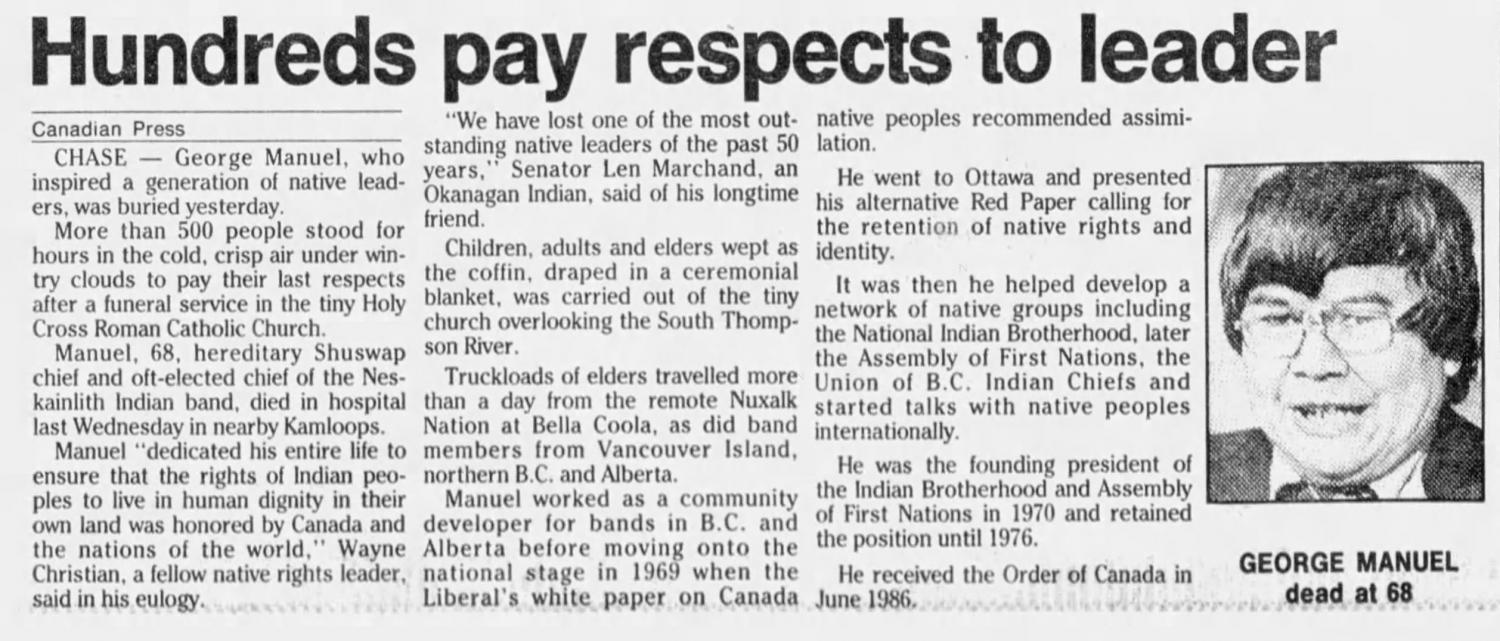George Manuel
Secwépemc chief was a forefather to the U.N.’s Declaration on the Rights of Indigenous Peoples
Date: 1975
Once described as a “hard-luck Shuswap kid,” George Manuel caught tuberculosis at the residential school in Kamloops when he was 12. He battled the illness for a decade, including three years spent in a sanatorium. It left him with a lifetime limp. And though it took Manuel out of school, he later said he used that solitude to teach himself from books. His intellect and tireless determination enabled him to push Indigenous rights — once an entirely foreign concept to most — to the fore.
In the 1960s, Manuel, now in his forties, served as president of the North American Indian Brotherhood of B.C. and an elected chief of the Neskonlith Band, a member of the Shuswap, or Secwépemc, Nation. But it wasn’t until Pierre Elliott Trudeau’s government released its widely-denounced “White Paper” in 1969 that Manuel assumed a role on the national stage. The controversial plan introduced by then-Minister of Indian Affairs Jean Chrétien proposed making Indigenous people “equal” to non-Indigenous Canadians by eliminating Indian status, all existing treaties and government programs available exclusively to First Nations, as well as converting reserves to private property, among other dramatic reforms.
Manuel and other First Nations activists viewed the document as another attempt to force assimilation on Indigenous people. “Canada was dead set on wiping out Indians once and for all,” he later remarked. At the time, he put it this way: “We want to remain different.” Thanks to vocal pushback from activists like Manuel, the Trudeau government withdrew the White Paper the following year.
In the fall of 1970, Manuel became the second president of the National Indian Brotherhood (NIB), now the Assembly of First Nations. Under his leadership, the young organization became a power-broker in Indigenous affairs. How Manuel spoke in those days closely resembles the words of Indigenous activists half a century later. At times, he was blunt: “Almost all of British Columbia and Quebec and parts of Ontario are without treaties extinguishing title and providing compensation. We own those places. They are ours. You are squatters.” Other times, he framed his views more gently: “We do not want to have the whole river to ourselves, but we do want to steer our own canoe without being rammed by the bigger ships around us.”
As leader of the NIB, Manuel started looking beyond Canada’s borders. After meeting with Indigenous communities overseas, including in New Zealand, Australia and Scandinavia, Manuel realized how similar their struggles were to First Nations in Canada. In 1975, he established the U.N.-affiliated World Council of Indigenous Peoples. Manuel later proposed drafting a declaration on the global rights of Indigenous people. That eventually turned into the seminal United Nations Declaration on the Rights of Indigenous Peoples (UNDRIP), which Manuel’s late son Arthur also had a hand in writing.
In 1979, Manuel, then president of the Union of B.C. Indian Chiefs, led hundreds of Indigenous people on a 4,800-kilometre train journey to Ottawa as politicians and bureaucrats drafted Canada’s new constitution. The “Indian Constitution Express” pressured Prime Minister Trudeau to include Aboriginal rights in the upcoming constitution — and it paid off. Section 35 of the Constitution Act, 1982 protects the ancestral and treaty rights of Canada’s Indigenous people and has been successfully used to defend those rights in court.
Following a series of heart attacks, Manuel passed away in 1989, not far from where he was born. More than 30 years after his death, the way governments discuss Indigenous rights remains largely shaped by the work of that “hard-luck” kid from the Neskonlith reserve. In 2019, British Columbia became the first government in Canada to commit to the principles of UNDRIP.
Sources:
- Cooperman, Jim. "Shuswap’s Internationally Renowned Chief George Manuel." Shuswap Passion, https://shuswappassion.ca/history/shuswaps-internationally-renowned-chief-george-manuel/. Accessed 7 May 2021.
- "Global Actions." Indigenous Foundations, 1 Jan. 2011, https://indigenousfoundations.arts.ubc.ca/global_actions/.
- Griffin, Kevin. "Canada 150: George Manuel Inspired a Generation of Indigenous Leaders." Vancouver Sun, 8 May 2017, https://vancouversun.com/news/local-news/canada-150/canada-150-george-manuel-inspired-a-generation-of-indigenous-leaders.
- Lagace, Naithan, and Niigaanwewidam James Sinclair. "The White Paper, 1969." The Canadian Encyclopedia, 24 Sept. 2015, https://www.thecanadianencyclopedia.ca/en/article/the-white-paper-1969.
- Lee, Angela. "George Manuel." Indigenous Foundations, https://indigenousfoundations.arts.ubc.ca/george_manuel/. Accessed 5 July 2021.
- Manuel, George. "Manifesto for Survival." Maclean’s | The Complete Archive, 1 May 1973, https://archive.macleans.ca/article/1973/5/1/manifesto-for-survival.
- ---. The Fourth World. U of Minnesota Press, 2019.
- "Module 5: Preface." The UN Declaration on the Rights of Indigenous Peoples, https://static1.squarespace.com/static/562e7f2ae4b018ac41a6e050/t/5abbea5faa4a99a0ab623de6/1522264674936/Module+7+-+UNDRIP.pdf. Accessed 7 May 2021.
- Ryser, Rudolph C. The Legacy of Grand Chief George Manuel. Center for World Indigenous Studies, 1995, https://www.cwis.org/wp-content/uploads/documents/premium/293DP10005.pdf.
- Turcotte, Yanick. "George Manuel." The Canadian Encyclopedia, 4 July 2019, https://www.thecanadianencyclopedia.ca/en/article/george-manuel.
- "UN Indigenous Rights Bill Approved Unanimously in B.C. Legislature." The Globe and Mail, 26 Nov. 2019, https://www.theglobeandmail.com/canada/british-columbia/article-bc-first-nations-leaders-worry-legislation-to-align-laws-with-undrip/.
- Wilson, Kory. "Indian Act Timeline." Pulling Together: Foundations Guide, BCcampus Open Publishing, 5 Sept. 2018.




